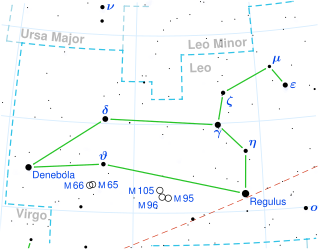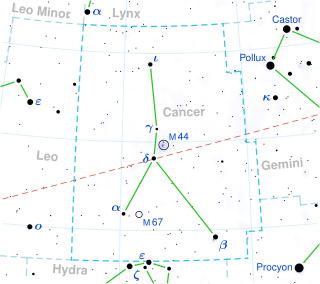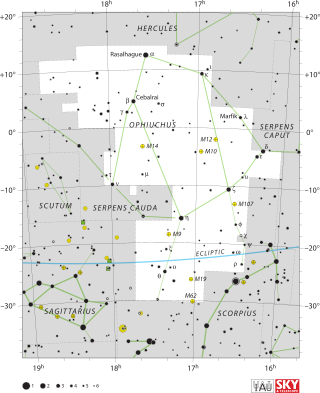
Beta Tauri is the second-brightest star in the constellation of Taurus. It has the official name Elnath; Beta Tauri is the current Bayer designation, which is Latinised from β Tauri and abbreviated Beta Tau or β Tau. The original designation of Gamma Aurigae is now rarely used. It is a chemically peculiar B7 giant star, 134 light years away from the Sun with an apparent magnitude of 1.65.

Bellatrix is the third-brightest star in the constellation of Orion, positioned 5° west of the red supergiant Betelgeuse. It has the Bayer designation γ Orionis, which is Latinized to Gamma Orionis. With a slightly variable magnitude of around 1.6, it is typically the 25th-brightest star in the night sky. Located at a distance of 250±10 light-years from the Sun, it is a blue giant star around 7.7 times as massive as the sun with 5.75 times its diameter.

Meissa, designated Lambda Orionis is a star in the constellation of Orion. It is a multiple star approximately 1,300 ly away with a combined apparent magnitude of 3.33. The main components are an O8 giant star and a B-class main sequence star, separated by about 4″. Despite Meissa being more luminous and only slightly further away than Rigel, it appears 3 magnitudes dimmer at visual wavelengths, with much of its radiation emitted in the ultraviolet due to its high temperature.

Gamma Pegasi is a star in the constellation of Pegasus, located at the southeast corner of the asterism known as the Great Square. It has the formal name Algenib ; the Bayer designation Gamma Pegasi is Latinized from γ Pegasi and abbreviated Gamma Peg or γ Peg. The average apparent visual magnitude of +2.84 makes this the fourth-brightest star in the constellation. The distance to this star has been measured using the parallax technique, yielding a value of roughly 470 light-years.

Gamma Leonis, also named Algieba, is a binary star system in the constellation of Leo. In 2009, a planetary companion around the primary was announced.

Gamma Arietis is a binary star in the northern constellation of Aries. The two components are designated γ1 Arietis or Gamma Arietis B and γ2 Arietis or Gamma Arietis A. γ1 Arietis may itself be a spectroscopic binary with a low mass companion.
21 Tauri, formally known as Asterope, is a component of the Asterope double star in the Pleiades open cluster. 21 Tauri is the stars' Flamsteed designation. This star is potentially faintly visible to the naked eye with an apparent visual magnitude of 5.76 in ideal conditions, although anybody viewing the object is likely to instead see the pair as a single elongated form of magnitude 5.6. The distance to 21 Tauri can be estimated from its annual parallax shift of 7.6 mas, yielding a range of around 431 light years. It is moving further from the Earth with a heliocentric radial velocity of +6 km/s.

Gamma Cancri, or γ Cancri, is a star in the northern constellation of Cancer. It is formally named Asellus Borealis, the traditional name of the system. Based on parallax measurements, it is located at a distance of approximately 181 light years from the Sun. The star is drifting further away with a radial velocity of 29 km/s. In 1910 this star was reported to be a spectroscopic binary by O. J. Lee, but is now considered a single star. Since it is near the ecliptic, it can be occulted by the Moon and, very rarely, by planets.

Gamma Capricorni or γ Capricorni, formally named Nashira, is a giant star in the constellation of Capricornus. Based on parallax measurements obtained during the Hipparcos mission, it is located at a distance of approximately 157 light-years from the Sun. The star is drifting closer with a radial velocity of −31 km/s. It is 2.56 degrees south of the ecliptic, so it can be occulted by the Moon, and (rarely) by planets.

Epsilon Ophiuchi or ε Ophiuchi, formally named Yed Posterior, is a red giant star in the constellation of Ophiuchus. Located less than five degrees south of the celestial equator in the eastern part of the constellation, it forms a naked eye optical double with Delta Ophiuchi. With an apparent visual magnitude of 3.220, the star can be seen with the naked eye from most of the Earth under suitably dark skies. Parallax measurements yield an estimated distance of 106.4 light-years from the Sun.

Theta Tauri is a wide double star in the constellation of Taurus and a member of the Hyades open cluster.

Merope, designated 23 Tauri, is a star in the constellation of Taurus and a member of the Pleiades star cluster. It is approximately 440 light-years (135 pc) away.
Pi Tauri is a solitary, yellow-hued star in the zodiac constellation of Taurus. With an apparent visual magnitude of +4.69, it is bright enough to be visible to the naked eye. Although it appears to lie among the stars of the Hyades cluster, it is not itself a member, being three times farther from Earth than the cluster. The distance to this star, as determined using an annual parallax shift of 7.83 mas as seen from the Earth, is around 420 light years. At that range, the visual magnitude of the star is diminished by an extinction factor of 0.24 due to interstellar dust.

Gamma Lyrae, Latinised from γ Lyrae, and formally named Sulafat, is the second-brightest star in the northern constellation of Lyra. With an apparent visual magnitude of 3.3, it is readily visible to the naked eye. Parallax measurements yield an estimated distance of 620 light-years from the Sun. At that distance, the visual magnitude of the star is diminished by an extinction factor of 0.12±0.03 due to interstellar dust.

Delta¹ Tauri is a double star in the zodiac constellation of Taurus. Based upon an annual parallax shift of 20.96 mas as seen from Earth, it is located roughly 156 light-years distant from the Sun. The system is faintly visible to the naked eye with a combined apparent visual magnitude of +3.772. It is considered a member of the Hyades cluster.

G Scorpii, also named Fuyue, is a giant star in the constellation of Scorpius. It has an apparent magnitude of +3.19. It is approximately 126 light-years from the Sun.

Delta2 Tauri is a solitary, white-hued star in the zodiac constellation of Taurus. Based upon an annual parallax shift of 20.21 mas as seen from Earth, it is located roughly 161 light years distant from the Sun. It is separated from δ1 Tauri by 0.3° on the sky and is faintly visible to the naked eye with an apparent visual magnitude of +4.80. The star is considered a member of the Hyades cluster.

Gamma Canis Majoris, also named Muliphein, is a star in the constellation of Canis Major. It is unclear exactly why this relatively faint star was given the 'gamma' designation, but possibly because it is in the same part of the constellation as Sirius (alpha) and Mirzam (beta).

Gamma Librae is a suspected binary star system in the constellation of Libra. It is visible to the naked eye, having an apparent visual magnitude of +3.91. Based upon an annual parallax shift of 19.99 mas as seen from Earth, it lies 163 light years from the Sun.

Gamma Gruis or γ Gruis, formally named Aldhanab, is a star in the southern constellation of Grus. With an apparent visual magnitude of 3.0, it is the third-brightest star in Grus. Based upon parallax measurements, this star is located at a distance of roughly 211 light-years from the Sun.

















